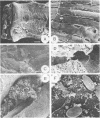Abstract
Healthy, actively feeding intertidal oysters were removed from an estuarine environment (Pipeclay Lagoon, Tasmania). The epithelial surfaces of various organs of the mantle cavity and alimentary tract were explored by scanning and transmission electron microscopy. All epithelial tissues examined were ciliated, and nearly all were partly covered with secreted mucus. However, microorganisms were seen rarely in the adhesive mucus and never attached to the epithelium. Electron microscopy also failed to demonstrate a surface microflora in emersed oysters which had been incubated at 5 to 25 degrees C for 6 or 24 h. The absence of an internal surface microflora did not vary on a seasonal basis. In laboratory experiments, oysters were allowed to filter feed from seawater containing diverse types of marine bacteria at concentrations of 10(3) to 10(7)/mL. However, no surface microflora could be found within actively feeding oysters or in emersed animals incubated at 20 degrees C for 6 or 24 h. In contrast, surface-associated microorganisms were detected readily by scanning electron microscopy on the external shell of healthy oysters and on various internal tissues in spoiled oysters. It is suggested that the major mechanisms restricting microbial growth within oysters are ciliary movement and mucus secretion.
Full text
PDF






Images in this article
Selected References
These references are in PubMed. This may not be the complete list of references from this article.
- Bloodgood R. A. The squid accessory nidamental gland: ultrastructure and association with bacteria. Tissue Cell. 1977;9(2):197–208. doi: 10.1016/0040-8166(77)90016-7. [DOI] [PubMed] [Google Scholar]
- Boyle P. J., Mitchell R. Absence of microorganisms in crustacean digestive tracts. Science. 1978 Jun 9;200(4346):1157–1159. doi: 10.1126/science.200.4346.1157. [DOI] [PubMed] [Google Scholar]
- Brown R. K., McMeekin T. A., Balis C. Effect of some unicellular algae on Escherichia coli populations in sea water and oysters. J Appl Bacteriol. 1977 Aug;43(1):129–136. doi: 10.1111/j.1365-2672.1977.tb00731.x. [DOI] [PubMed] [Google Scholar]
- Burkholder P. R., Sharma G. M. Antimicrobial agents from the sea. Lloydia. 1969 Dec;32(4):466–483. [PubMed] [Google Scholar]
- COLWELL R. R., LISTON J. Microbiology of shellfish. Bacteriological study of the natural flora of Pacific oysters (Crassostrea gigas). Appl Microbiol. 1960 Mar;8:104–109. doi: 10.1128/am.8.2.104-109.1960. [DOI] [PMC free article] [PubMed] [Google Scholar]
- Garland C. D., Lee A., Dickson M. R. The preservation of surface-associated micro-organisms prepared for scanning electron microscopy. J Microsc. 1979 Jul;116(2):227–242. doi: 10.1111/j.1365-2818.1979.tb00204.x. [DOI] [PubMed] [Google Scholar]
- Savage D. C. Microbial ecology of the gastrointestinal tract. Annu Rev Microbiol. 1977;31:107–133. doi: 10.1146/annurev.mi.31.100177.000543. [DOI] [PubMed] [Google Scholar]
- Tall B. D., Nauman R. K. Scanning electron microscopy of cristispira species in chesapeake bay oysters. Appl Environ Microbiol. 1981 Aug;42(2):336–343. doi: 10.1128/aem.42.2.336-343.1981. [DOI] [PMC free article] [PubMed] [Google Scholar]





